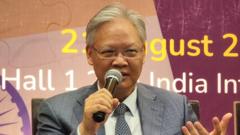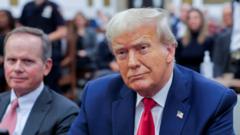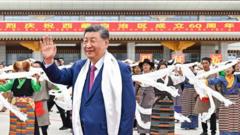Apple's intricate supply chain in China remains critical, but US-China tensions force the tech giant to reconsider its future.
**From Design to Dependency: Apple's Complex Relationship with China**

**From Design to Dependency: Apple's Complex Relationship with China**
Amid rising tariffs and political tensions, Apple's reliance on Chinese manufacturing poses significant challenges.
Much like the sleek design of its products, the relationship between Apple and China is multifaceted and intricate. Designed in the United States to compete in a vast global market, Apple's products—particularly iPhones—are predominantly manufactured in China. This dependency is further complicated by the ongoing trade tensions between the two largest economies, especially under initiatives from the previous US administration.
Every iPhone proudly labels its point of design as California, yet the reality is that around 90% of production takes place thousands of miles away in China. The implications of rising tariffs, which can soar as high as 245% on certain imports, lead to heightened scrutiny of the tech giant's supply chains. Recently, despite being granted short-term exemptions on some electronic devices, Apple faces the looming threat of increased tariffs, rendering its global supply chain vulnerable at a moment's notice.
Historically, Apple has secured its foothold in China by capitalizing on a booming economy eager to engage with global brands. As early as the 1990s, Apple began selling computers in China, ultimately partnering with Taiwanese manufacturer Foxconn, which now operates the world's largest iPhone factory. Over the years, this partnership allowed Apple to not only flourish in the Chinese market but also tap into a burgeoning manufacturing powerhouse.
However, the luxury of a global supply chain can quickly turn into a liability. The recent administration's push for American manufacturing signals a shift in policy, suggesting that businesses like Apple may need to reevaluate their reliance on China. Although Apple has expressed intentions to diversify its supply chain—looking to countries like Vietnam and India as possible alternatives—commentators remain skeptical about a full-scale relocation. The logistics, costs, and talent pool available in China present significant challenges in shifting production.
The stakes are high for China as well; Apple is a key player in the economy, providing jobs and supporting a vast network of suppliers. A step back from manufacturing could hinder China’s economic recovery post-pandemic, deepening local vulnerabilities. While local companies such as Huawei and Vivo have begun to reclaim market share from Apple, Beijing’s firm stance against US trade pressures complicates the scenario further.
As Apple navigates these turbulent waters, analysts note that any alterations to its supply chain will not happen overnight. The rise of competing domestic brands is indicative of a rapidly changing consumer landscape in China. Furthermore, domestic policies under Xi Jinping place additional restrictions on foreign technology firms, which could further limit Apple's operations.
In response to economic pressures and competition, Apple has committed significant funds—up to $500 billion—to investments in the US market. Nonetheless, the firm continues to confront the dual threats of tariffs and fierce competition, all while attempting to maintain its foothold in the world’s most populous market. As the tech giant adjusts to the changing dynamics of US-China relations, its future may hinge not only on its ability to innovate but also on how well it can adapt to an increasingly adversarial environment.
The challenges facing Apple exemplify the complexities of globalization and the interconnectedness of economies, highlighting how quickly hot geopolitical issues can alter commercial realities. The company’s response in the coming months may not only shape its trajectory but also have lasting implications on the future of international supply chains and trade relations.
Every iPhone proudly labels its point of design as California, yet the reality is that around 90% of production takes place thousands of miles away in China. The implications of rising tariffs, which can soar as high as 245% on certain imports, lead to heightened scrutiny of the tech giant's supply chains. Recently, despite being granted short-term exemptions on some electronic devices, Apple faces the looming threat of increased tariffs, rendering its global supply chain vulnerable at a moment's notice.
Historically, Apple has secured its foothold in China by capitalizing on a booming economy eager to engage with global brands. As early as the 1990s, Apple began selling computers in China, ultimately partnering with Taiwanese manufacturer Foxconn, which now operates the world's largest iPhone factory. Over the years, this partnership allowed Apple to not only flourish in the Chinese market but also tap into a burgeoning manufacturing powerhouse.
However, the luxury of a global supply chain can quickly turn into a liability. The recent administration's push for American manufacturing signals a shift in policy, suggesting that businesses like Apple may need to reevaluate their reliance on China. Although Apple has expressed intentions to diversify its supply chain—looking to countries like Vietnam and India as possible alternatives—commentators remain skeptical about a full-scale relocation. The logistics, costs, and talent pool available in China present significant challenges in shifting production.
The stakes are high for China as well; Apple is a key player in the economy, providing jobs and supporting a vast network of suppliers. A step back from manufacturing could hinder China’s economic recovery post-pandemic, deepening local vulnerabilities. While local companies such as Huawei and Vivo have begun to reclaim market share from Apple, Beijing’s firm stance against US trade pressures complicates the scenario further.
As Apple navigates these turbulent waters, analysts note that any alterations to its supply chain will not happen overnight. The rise of competing domestic brands is indicative of a rapidly changing consumer landscape in China. Furthermore, domestic policies under Xi Jinping place additional restrictions on foreign technology firms, which could further limit Apple's operations.
In response to economic pressures and competition, Apple has committed significant funds—up to $500 billion—to investments in the US market. Nonetheless, the firm continues to confront the dual threats of tariffs and fierce competition, all while attempting to maintain its foothold in the world’s most populous market. As the tech giant adjusts to the changing dynamics of US-China relations, its future may hinge not only on its ability to innovate but also on how well it can adapt to an increasingly adversarial environment.
The challenges facing Apple exemplify the complexities of globalization and the interconnectedness of economies, highlighting how quickly hot geopolitical issues can alter commercial realities. The company’s response in the coming months may not only shape its trajectory but also have lasting implications on the future of international supply chains and trade relations.


















